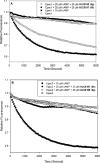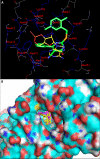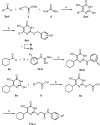5-Cyano-6-oxo-1,6-dihydro-pyrimidines as potent antagonists targeting exchange proteins directly activated by cAMP
- PMID: 22607683
- PMCID: PMC3362663
- DOI: 10.1016/j.bmcl.2012.04.082
5-Cyano-6-oxo-1,6-dihydro-pyrimidines as potent antagonists targeting exchange proteins directly activated by cAMP
Abstract
Exchange proteins directly activated by cAMP (Epac) are a family of guanine nucleotide exchange factors that regulate a wide variety of intracellular processes in response to second messenger cAMP. To explore the structural determinants for Epac antagonist properties of high throughput screening (HTS) hit ESI-08, pyrimidine 1, a series of 5-cyano-6-oxo-1,6-dihydro-pyrimidine analogues have been synthesized and evaluated for their activities for Epac inhibition. Structure-activity relationship (SAR) analysis led to the identification of three more potent Epac antagonists (6b, 6g, and 6h). These inhibitors may serve as valuable pharmacological probes for further elucidation of the physiological functions and mechanisms of Epac regulation. Our SAR results and molecular docking studies have also revealed that further optimization of the moieties at the C-6 position of pyrimidine scaffold may allow us to discover more potent Epac-specific antagonists.
Copyright © 2012 Elsevier Ltd. All rights reserved.
Figures







Similar articles
-
Recent advances in the discovery of small molecules targeting exchange proteins directly activated by cAMP (EPAC).J Med Chem. 2014 May 8;57(9):3651-65. doi: 10.1021/jm401425e. Epub 2013 Nov 27. J Med Chem. 2014. PMID: 24256330 Free PMC article. Review.
-
Structure-Activity Relationship Studies of Substituted 2-(Isoxazol-3-yl)-2-oxo-N'-phenyl-acetohydrazonoyl Cyanide Analogues: Identification of Potent Exchange Proteins Directly Activated by cAMP (EPAC) Antagonists.J Med Chem. 2015 Aug 13;58(15):6033-47. doi: 10.1021/acs.jmedchem.5b00635. Epub 2015 Jul 16. J Med Chem. 2015. PMID: 26151319 Free PMC article.
-
Isoform-specific antagonists of exchange proteins directly activated by cAMP.Proc Natl Acad Sci U S A. 2012 Nov 6;109(45):18613-8. doi: 10.1073/pnas.1210209109. Epub 2012 Oct 22. Proc Natl Acad Sci U S A. 2012. PMID: 23091014 Free PMC article.
-
Identification of novel 2-(benzo[d]isoxazol-3-yl)-2-oxo-N-phenylacetohydrazonoyl cyanide analoguesas potent EPAC antagonists.Eur J Med Chem. 2017 Jul 7;134:62-71. doi: 10.1016/j.ejmech.2017.04.001. Epub 2017 Apr 4. Eur J Med Chem. 2017. PMID: 28399451 Free PMC article.
-
Exchange proteins directly activated by cAMP (EPACs): Emerging therapeutic targets.Bioorg Med Chem Lett. 2017 Apr 15;27(8):1633-1639. doi: 10.1016/j.bmcl.2017.02.065. Epub 2017 Feb 27. Bioorg Med Chem Lett. 2017. PMID: 28283242 Free PMC article. Review.
Cited by
-
Discovery of potent anticancer agent HJC0416, an orally bioavailable small molecule inhibitor of signal transducer and activator of transcription 3 (STAT3).Eur J Med Chem. 2014 Jul 23;82:195-203. doi: 10.1016/j.ejmech.2014.05.049. Epub 2014 May 22. Eur J Med Chem. 2014. PMID: 24904966 Free PMC article.
-
Prostaglandin E2 Inhibits Histamine-Evoked Ca2+ Release in Human Aortic Smooth Muscle Cells through Hyperactive cAMP Signaling Junctions and Protein Kinase A.Mol Pharmacol. 2017 Nov;92(5):533-545. doi: 10.1124/mol.117.109249. Epub 2017 Sep 6. Mol Pharmacol. 2017. PMID: 28877931 Free PMC article.
-
Targeting the Small GTPase Superfamily through Their Regulatory Proteins.Angew Chem Int Ed Engl. 2020 Apr 16;59(16):6342-6366. doi: 10.1002/anie.201900585. Epub 2020 Jan 30. Angew Chem Int Ed Engl. 2020. PMID: 30869179 Free PMC article. Review.
-
IL-6 translation is a therapeutic target of human cytokine release syndrome.J Exp Med. 2023 Nov 6;220(11):e20230577. doi: 10.1084/jem.20230577. Epub 2023 Aug 16. J Exp Med. 2023. PMID: 37584653 Free PMC article.
-
Recent advances in the discovery of small molecules targeting exchange proteins directly activated by cAMP (EPAC).J Med Chem. 2014 May 8;57(9):3651-65. doi: 10.1021/jm401425e. Epub 2013 Nov 27. J Med Chem. 2014. PMID: 24256330 Free PMC article. Review.
References
Publication types
MeSH terms
Substances
Grants and funding
LinkOut - more resources
Full Text Sources
Other Literature Sources
Chemical Information
Molecular Biology Databases
Miscellaneous

